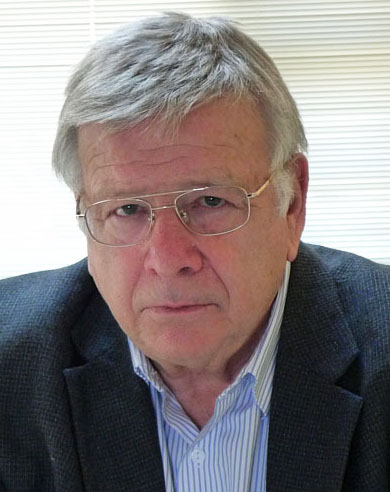
Gerald S. Guralnik, a revered member of the Brown faculty for 47 years whose theoretical work helped complete the Standard Model of particle physics, died Saturday, April 26, 2014. He was 77.
Guralnik, the Chancellor’s Professor of Physics at Brown, was a leading theorist in the field of elementary particle theory and made enduring contributions to the understanding of mass in the universe.
“Gerry forged his own path and yet always focused on fundamental issues in physics,” said Chung-I Tan, professor of physics at Brown and a longtime colleague of Guralnik’s. “He was an early advocate and important contributor to the numerical approach to quantum field theories and also in exploring the structure of strong coupling expansion – paving the way for two of the most important current research areas in theoretical particle physics.”
In 1964, Guralnik and colleagues C.R. Hagen and Tom Kibble published what would become a landmark paper in particle physics. The paper described a field pervading space that breaks the symmetry between the electromagnetic and weak nuclear forces, explaining why the elementary particles that make up matter have mass, while photons (particles of light) are massless. The paper came just months after two other papers — one by Peter Higgs and another by Francois Englert and Robert Brout — which described a similar mechanism.
The physical manifestation of that mechanism, which would become known as the Higgs boson, was discovered by scientists in 2012 at the Large Hadron Collider in Switzerland. The boson was considered to be the final missing piece of the Standard Model of particle physics.
“It is a wonderful feeling of great satisfaction and amazement,” Guralnik said shortly after the discovery that proved his theory. “We started out to solve an interesting and challenging abstract problem; we were surprised by the answer that turned up.”
Guralnik, born in Cedar Falls, Iowa, joined the faculty at Brown as an assistant professor in 1967 following postdoctoral research at the University of Rochester. He received his Ph.D. from Harvard in 1964 and conducted research at Imperial College, London, on a National Science Foundation postdoctoral fellowship. He was a fellow of the American Physical Society and was an Alfred P. Sloan Research Foundation fellow.
Though Guralnik’s 1964 paper would become vastly influential, it took years for his ideas to become mainstream, as he described in an essay for the Huffington Post.
“Werner Heisenberg (Nobel Prize in physics, 1932), one of the most important physicists of the 20th century, made it clear to me in the summer of 1965, at a conference in his honor, that he thought these ideas were junk,” Guralnik wrote. “Another great 20th century physicist, Robert Marshak, told me that if I wished to survive in physics I must stop thinking about this sort of problem and move on. I wisely obeyed, but I was thrilled a few years later when Steve Weinberg and then Abdus Salam used our mechanism and a generalization of our simple example to build the unified model of weak and electromagnetic interactions and later, with Sheldon Glashow, received Nobel Prizes.”
Brown faculty members remember Guralnik as a committed educator, who always offered guidance to students and junior colleagues.
“Gerry was above all a kind and generous man, as well as a beloved colleague,” said James Valles, chair of the Department of Physics at Brown. “In addition to his unique and lasting contributions in theoretical physics, he was a passionate teacher who mentored countless undergraduates, graduate students and junior faculty members. We will miss him deeply.”
“He had compassion for others,” Tan said, “and quietly performed acts of kindness without any expectation of reciprocity.”
Guralnik remained humbly pleased with the lasting power of his theory of symmetry-breaking and mass.
As he told the Wall Street Journal, “We are amazed and delighted that our mathematical exercise turned out to play a huge part in describing how nature works.”
(Read President Paxson’s note to the community.)
